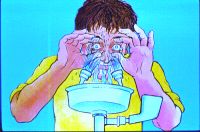| Personal Protective Equipment |

|
|
1 - Personal Protective Equipment
2 - Page 2 |

 |
OSHA's new final standard on personal protective equipment, 29CFR 1910 132, Subpart imposes several new and important requirements relating to basic safety and health programs. The standard adds new general requirements for the selection and use of personal protective equipment (PPE). Included in these requirements are the following:
- Employers must conduct a hazard assessment to determine if hazards present necessitate
the use of PPE. - Employers must certify in writing that the hazard assessment was conducted.
- PPE selection must be made on the basis of hazard assessment and affected workers
properly trained. - Defective or damaged PPE must not be used.
- Established training requirements for employees using PPE must be established. This should include requirements for employees to demonstrate an understanding of the training.
- Employer must certify in writing that training programs were provided and understood.
A variety of laboratory personal protective equipment is commercially available and commonly used in laboratories. However, for the equipment to perform the desired function, it must be used and managed properly. Laboratory supervisors and/or departmental chemical hygiene officers shall determine a need for such equipment, monitor its effectiveness, train the employees, and monitor and enforce the proper use of such equipment.
Eye Protection
Eye protection is mandatory in all areas where there is potential for injury. This applies to both permanent and temporary employees.
   |
For most situations, safety glasses with side shields are adequate. Please note that the wearing of safety glasses does not excuse the employee from the requirement of wearing safety goggles.
- Where there is a danger of splashing chemicals, flying particles, goggles are required. Examples are: washing glassware in chromic acid solution, grinding materials, or laboratory operations using glassware where there is significant hazard of explosion or breakage (i.e., in reduced or excess pressure or temperature).
- More hazardous operations include conducting reactions which have potential for explosion and using or mixing strong caustics or acids. In these situations, a face shield or a combination of face shield and safety goggles or glasses should be used.
- It is recommended that contact lenses not be permitted in the laboratory. The reasons for this prohibition are:
- If a corrosive liquid should splash in the eye, the natural reflex to clamp the eyelids shut makes it very difficult, if not impossible, to remove the contact lens before damage is done.
- The plastic used in contact lenses is permeable to some of the vapors found in the laboratory. These vapors can be trapped behind the lenses and can cause extensive irritation.
The lenses can prevent tears from removing the irritant. If the employee choose to wear contact lenses then they shall wear the protective goggles which fits loosely around the eyes and have no vents for access by vapors. If chemical vapors contact the eyes while wearing contact lenses, these steps should be followed:
- Immediately remove the lenses.
- Continuously flush the eyes, for at least 15 to 30 minutes.
- Seek medical attention.

- If, despite all precautions, an employee should experience a splash of corrosive liquid in the eye, the employee is to proceed (with the assistance of a co-worker, if possible) to the nearest eyewash fountain and flush the eyes with water for at least 15 to 30 minutes. Flush from the eye outward. During this time, a co-worker should notify the proper authorities.
- Visitors shall follow the same eye protection policy as employees. If they do not provide their own eye protection, it is the laboratory's responsibility to provide adequate protection. It should be the responsibility of the employee conducting the tour to enforce this policy. After use safety glasses/goggles used by visitors should be cleaned prior to reuse.
Clothing
The following guidelines for laboratory clothing are offered strictly from a safety standpoint.
- Due to the potential for ignition, absorption, and entanglement in machinery, loose or torn clothing should be avoided unless wearing a lab coat.
- Dangling jewelry and excessively long hair pose the same type of safety hazard.
- Finger rings or other tight jewelry which is not easily removed should be avoided because of the danger of corrosive or irritating liquids getting underneath the piece and producing irritation.
- Lab coats should be provided for protection and convenience. They should be worn at all times in the lab areas. Due to the possible absorption and accumulation of chemicals in the material, lab coats should not be worn in the lunchroom or elsewhere outside the laboratory.
- Where infectious materials are present, closed (snapped) lab coats and gloves are essential.
- Shoes shall be worn at all times in the laboratories. Sandals, open-toed shoes, and shoes with woven uppers, shall not be worn because of the danger of spillage of corrosive or irritating chemicals.
- Care should be exercised in protective clothing selection; some protective clothing has very limited resistance to selected chemicals or fire.
- Consult the MSDS for a chemical to find out the recommended clothing or PPE for a particular chemical. (Examples are latex, nitrile, or PVC gloves, or aprons.)
Glove Selection Guide
A Table of Suggested Glove Selection for Incidental and Extended Chemical Contacts | ||
Chemical | Incidental Contact | Extended Contact |
| Acetic Acid | nitrile | neoprene, butyl rubber |
| Acetic Anhydride | nitrile (8 mil), double glove | neoprene, butyl rubber |
| Acetone | natural rubber (latex)(8 mil) | butyl rubber |
| Acrylamide | nitrile | butyl rubber, polyvinyl acetate (PVA) |
| bis-Acrylamide | Nitrile | |
| Alkali Metals | nitrile | |
| Ammonium Hydroxide | Nitrile | neoprene, buty rubber |
| Arsenic Salts | nitrile | |
| Benzotriazola, 1,2,3- | nitrile | |
| Butanol | nitrile | neoprene, buty rubber |
| Butyric Acid | nitrile | neoprene, buty rubber |
| Cadmium Salts | nitrile | |
| Carbon Disulfide | nitrile (8 mil), double glove, or 15 mil or heavier | viton, polyvinyl acetate |
| Carbon Tetrachloride | nitrile (8 mil), double glove, or 15 mil or heavier | viton |
| Catechol | nitrile (8 mil), double glove, or 15 mil or heavier | |
| Chloroform | nitrile (8 mil), double glove, or 15 mil or heavier | viton, polyvinyl acetate (PVA) |
| Chlorosulfuron | nitrile | |
| Chromium Salts | nitrile | |
| Cobalt Chloride | nitrile | nitrile |
| Cobalt Salt | nitrile | |
| Copper (Cupric) Sulfate | nitrile | |
| Cyrogenic Liquids | cyro-gloves | |
| 3,3'-Diaminobenzidine (DAB) | nitrile | nitrile, double glove |
| Diazomethane in Ether | nitrile (8 mil), double glove, or 15 mil or heavier | norfoil |
| Dichloromethane | nitrile (8 mil), double glove | viton, polyvinyl acetate (PVA) |
| 2,4-Dichlorophenoxy acetic acid | nitrile | |
| 2,4-Dichlorophenoxy acetic acid | nitrile | |
| Diethyl Pyrocarbonate | nitrile | nitrile, double glove |
| Dimethyle Sulfoxide | natural rubber (15-18 mil) | butyl rubber |
| 1,4-Dioxane | nitrile (8 mil), double glove, or 15 mil or heavier | butyl rubber |
| Dithiothreitol | nitrile | |
| Ethanol | nitrile | |
| Ethidium Bromide (EtBr) | nitrile | nitrile, double glove |
| Ethyl Acetate | nitrile (8 mil), double glove | butyl rubber, PVA |
| Ethyl Ether | nitrile (8 mil), double glove, or 15 mil or heavier | polyvinyl acetate PVA |
| Formaldehyde | nitrile | |
| Formaide | nitrile | butyl rubber |
| Formic Acid | nitrile (8 mil), double glove | butyl rubber, neoprene (.28-.33mm) |
| Gallic Acid | nitrile | |
| Geneticin | nitrile | |
| Glutaraldehyde | nitrile | |
| Heavy Metal Salts | nitrile | nitrile, double glove |
| Heptane | nitrile (8 mil), double glove, or 15 mil or heavier | nitrile, (335 mils or thicker, viton, PVA |
| Hexamethylenediamine (1,6-Diaminohexane) | nitrile (8 mil) | neoprene |
| Hexane | nitrile (8 mil), double glove, 15 mil or heavier | nitrile (35 mils or thicker), viton, PVA) |
| Hydrochloric Acid | nitrile (8 mil) | neoprene, butyl rubber |
| Hydrofluoric Acid (HF) | nitrile (8 mil)double glove | nitrile or rubber sleeves |
| Hypophosphorous Acid | nitrile (4mil) , double glove or 8 mil or heavier | |
| Isoamyl alcohol | nitrile | |
| Isoctane | nitrile | heavier weight nitrile |
| Isopropanol | nitrile | |
| Kananmycin | nitrile | |
| Lactic Acid | nitrile | nitrile (double glove), or neoprene or butyl rubber |
| Lead Acetate | nitrile | nitrile (double glove) |
| Lead Salts | nitrile | |
| Mercuric Chloride | nitrile | nitrile (double glove) |
| Mercury | nitrile | |
| Mercury Salts | nitrile | |
| Methanol (Methyl alcohol) | nitrile | |
| Methanol Chloride | nitrile(8 mil), double glove | |
| Methylene | nitrile(8 mil), double glove | polyvinyl acetate, viton |
| Methylphosphonic Acid | nitrile (4 mil), double glove | 8 mil or heavier nitrile |
| Methyl Sulfonic Acid, Ethyl Ester (EMS) (Ethyl Methanesulfonate) | nitrile(8 mil) | nitrile, double glove |
| Monoethanolamine | nitrile | |
| Nickel Chloride | nitrile | nitrile, double glove |
| Nickel Salts | nitrile | nitrile, double glove |
| Nitric Acid | nitrile (8 mil), double glove | heavier weight (.28-.33mm) butyl rubber or neoprene |
| N-Methylethanolamine | nitrile (8 mil), double glove | viton, neoprene, butyl rubber |
 Quiz for the Personal Protective Equipment
Quiz for the Personal Protective Equipment
| [1] 2 Next >> |
